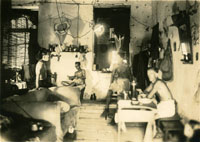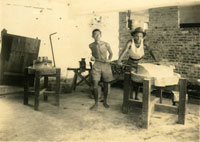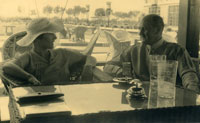
For the descendents of Richard Dearie and his son John Russell
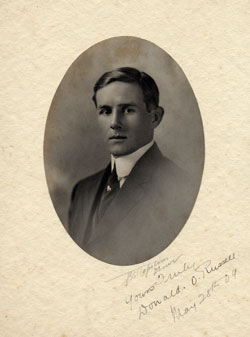
DONALD OSCAR RUSSELL’S LIFE
7 August 1887 - 8 July 1961
AS ASSEMBLED BY MICHAEL RUSSELL
FROM VARIOUS SOURCES AND HIS OWN RECOLLECTIONS
Youth and Education
Donald Oscar was born on 7th August 1887 at South View Villas, Elm Road, in New Malden, Surrey.
He travelled with his parents and four brothers on S.S. Glengarry in 1890 to Singapore, and after being there for several days they all travelled aboard the S.S. Sappho to Port Klang, and then on to Kuala Lumpur by steam train where they were accommodated in the previous Gaoler’s quarters.
After the tragic death of his mother on 16th January 1893, in a carriage accident in Singapore while taking her eldest son George to enter Raffles school there, Donald (Don) and three of his brothers, Archie, Phil, and Bob were sent by their father to England to live with their aunt Nell and her husband George Oxer at 135 Chadwick Road, Peckham, London. (Read his father's letter here.)
It is not clear where Don went to primary school while in England, but his father came to England briefly to bring the four sons back to Kuala Lumpur in 1899. Don would have been about 12 years old by then, and was next sent off to England again in 1902 for his secondary education at Crediton Grammar School in Devon.
James Edward Burton was the headmaster, and Don was awarded the 4th Form History and Geography prize on 30th July 1903 (See right).
It was during school holidays that he met the headmaster’s niece, Ethel Burton whom he later married.
At Crediton Grammar School
While he was at Crediton Grammar School, during some terms Don was seated for meals on a bench with his back against a side wall and a long table in front of him. Breakfast sometimes included a piece of scruffy bacon with tough grisly rind that was hard to chew. One term Don found that the wall behind him had an old small mouse hole at the base so, any morning when this awful bacon was served, he discretely started pushing the grisly rind into the old mouse hole. This went on for several days until one of the school’s masters caught him at it. The master made Don pull out all the rind, dirty and putrid, from the mouse hole and eat it while the other boys looked on. “Health and Safety” was not a reality in those days, and needless to say Don ate all the bacon grudgingly after that !
Archie stayed on in Malaya after having been brought back from England with three of his brothers and, having become strongly involved in the businesses of tin smelting and tin mining, Archie formed his own company J. A. Russell (JAR) or “Chop Tai Ying” in 1904. It was agreed by the family that, after Don’s secondary education was complete, he should be enrolled at the Colorado School of Mines (CSM), which he did in September 1905 and graduated with honours from there in 1909 as a Mining Engineer. It is interesting to note from one of Don’s old photographs that one of his brothers, Philip, visited Don at CSM and it is likely that Phil may have been in the United States on business for Loke Yew for whom he worked for a period.
Early working years in Malaya
Don then returned to Malaya in 1909 and joined Archie’s company. He was initially responsible for overseeing JAR’s tin mining operations, and he commented later in life that he had to take the monthly wages on a pedal cycle to one of the mines at Kepong. Among the many mines opened by JAR was a wolfram and tin mine at Kaki Bukit in the north of the State of Kedah. A family relative has told a story that it was extremely difficult to retain the Chinese labour required to operate this remote mine, and it was alleged that a gambling den and a brothel were set up to remedy this with the takings adding to the profits !
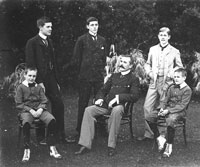
At the “Shebeen”
Sometime before Don graduated in 1909, his brothers were living as bachelors at a double-storey bungalow with a large garden and tennis court on the periphery of the race course in those days, the property being owned by the Race Club. Don joined them in 1909, but George married Madeline Dearie Mossop in September of the same year and left to live separately, so for several years there were various of the other four bachelor brothers living there.
They called the house “Shebeen”, apparently very aptly . It is said that no married women were ever allowed there, riotous weekend parties were quite frequent, and Sundays were extremely relaxed as the photos show. However when business was done during weekdays, it was done in earnest. They worked hard and they played hard. Incidentally, of the two sky-scraping Twin Towers now at what is called Kuala Lumpur City Centre, the south-westerly one is built on the old site of “Shebeen”.
After George Russell had married and left “Shebeen”, the remaining four brothers employed a new cook. They always had a decanter of sherry on the sideboard in case any guest might like some, but never drank any themselves. A few days after the new cook started work the brothers noted that the sherry had gone down substantially in the decanter, and so they asked each other whether they had invited any guest who had been offered some. The answer was “no” from all, so they decided to put a discreet mark on the level in the decanter, and watch it.
Some days later the sherry had gone down further, so the brothers concluded that the new cook must be imbibing it and agreed they would “fix” him. To do this, one of the brothers was elected to urinate into a jug and top this up in the decanter to the original level, which was done. They kept a close eye on this but found that the “sherry” still continued to drop, so they decided to have the matter out with the cook. They called him in one evening when they were all at home, told him that neither they nor any guests had consumed any sherry, and asked him what he had been up to. “Tuan (Sir)” the cook replied, “I thought you all like to have a little sherry in your soup each evening” !!
One of the Russell brothers fancied he could play the piano, there being one at Sheeben, but the others could not abide the racket of his discordant attempts to play some popular musical pieces. One Saturday evening when they had arranged a large party at Shebeen for various friends, the brothers decided it would be fun to have a bonfire on the drive in front of the house. The party was in full swing after dark, when it occurred to those brothers who could no longer stand the amateur piano playing of the one, that it would be a good time to get rid of the piano. So they, with the help of some friends, lifted up the piano, took it out of the door and with a coordinated heave threw it on top of the bonfire !
A prized possession of several of the Russell brothers at Shebeen was a collection of high quality cut-glass items held in a glass-fronted cabinet in the sitting-room, which was the main dwelling room of the house and the one used on party occasions. On one such occasion, a weekend party was in full swing with alcohol flowing freely as usual. Since Shebeen was rented from the Race Club and the race-course and stables were nearby, one of the guests who was probably well inebriated, thought it would be fun to go and bring a horse from the stables and ride it into the room at the party. This he did, but the horse soon took fright at the noise and revelry going on, and lashed out with its hind legs. This smashed the cabinet and most of the prized cut-glass in it, and you can imagine that the Russell brothers were furious about this, but the riotous party went on anyway !
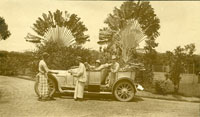
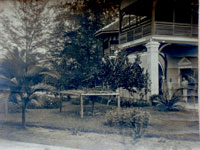
Coal, Property and Tin Mining
Sometime before 1909 it was believed also that a coal deposit of unknown size and quality existed in the Batu Arang area of Selangor State, and it is interesting to note that recent research has indicated that a license to prospect this deposit was granted initially to the London & Malay Syndicate Ltd but was then passed on to the Rawang F.M.S. Coal Syndicate. Archie (J.A.) was obviously aware of the deposit early on and became financially associated with that company in 1912. According to Don’s own notes (See Don's short history of the firm compiled in 1954), J.A. while he was on holiday in England met an old friend of the family who was a member of the Syndicate and had also been the Senior Warden of Mines. That friend was optimistic about the possibility of the deposit, whereas the rest of the Syndicate was not and offered J.A. an option over the property. J.A. then set up the Malayan Collieries and purchased the whole property and rights of the Syndicate in 1913. In Don’s own notes he states that his first job after joining JAR in 1909 was to examine and report on the possible discovery of coal at Batu Arang, which possibly sparked J.A.’s initial interest in the project. Don said subsequently that he also supervised the subsequent initial prospecting of the deposit, which proved it to be a viable concern.
Apparently getting Malayan Collieries going was tough at first. Several people who had intimated they would subscribe withdrew because a slump had taken place in rubber which fell to 8 shillings per lb. J.A. raised all the money possible on his investments and subscribed for shares while he also took his profit in shares. Machinery and equipment was ordered but the advent of war in 1914 made deliveries difficult, and it was really not until 1918 that the Collieries got going.
Prior to all that, J.A. had started to become interested in both rubber and property, and his Company JAR floated several estates and bought property including Kampong Malacca, now a highly developed part of Kuala Lumpur city,and the New Town area of Ipoh south of the Kinta river, in the State of Perak, from the Estate of Yau Tat Shin. The latter had been partly developed but was mostly rubber estate. JAR proceeded to further develop the estate extensively into shophouses which were rented out. The development was principally along the road first named Hugh Low Street and other side streets. There is still even now a road named “Russel Street” (note the spelling). Don remembered being assigned to to travel to Ipoh and collecting the rent from all the mainly Chinese tenants.
As shown in the attached research paper (See left and below) ,Don was handling both the tin mining and real estate business of JAR. He obtained a 1st class appraiser’s license and a 2nd class license for agricultural property. Don also owned a few tin mines in his own right but I understand that, after he had gone to Europe to fight in World War I, the leases on these were not renewed as they were not being worked sufficiently in his absence. Don was specifically responsible for acquiring the land for the Hong Kong & Shanghai Bank on which they built their head office at Benteng in Kuala Lumpur.
D.O. Russell’s Business Interests in Malaya
By working for the tin mining companies (Straits Trading Company and International Tin Corporation of U.S.A.), J.A. Russell saw the high profitability of tin industry. Hence, he established his own tin trading company – J.A. Russell & Co. or Chop Thai Ying in 1904 to tap the rich tin reserves in Malaya. Seeing the good prospect of the enterprise, the family decided to send D.O. Russell to study at the Colorado School of Mines in United States. After spending four years in the States, D.O., who graduated with honours, went to Malaya to join the J. A. Russell and Company in 1909. He was responsible not only in handling the tin business but also the real estate of the company. He was entrusted to take care of some 77 shops in the town of Kuala Lumpur, Seremban, Klang, Kajang and Serendah. D.O. himself negotiated most of the purchases. In 1911, he obtained a 1st class appraiser’s license for house property and mining land and a 2nd class license for agricultural property. Besides managing the company business, D.O. also acquired some tin mining lands for himself. By 1911, he owned 62 acres of tin mines with 584 coolies (1) working (See Table 1 below). About three years later, the area of tin mines owned by D.O. increased to 168 acres while the number of coolies decreased to 215 (See Table 2 below).
From research by Mr. Wong Yee Tuan
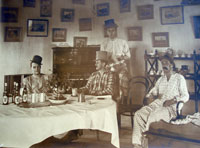
In 1918 Don made quite a hazardous voyage to Trengganu to inspect a mine that he had heard was for sale. Don’s own account of the voyage can be read here. “A Journey to Trengganu some 40 Years Ago”.
First World War, and first marriage
In 1914 when war broke out with Germany, Don travelled to England, joined 129th Field Company of the Royal Engineers, and served in France. He was promoted to Lieutenant early in 1916 and in the same year while on leave married Ethel Burton (the niece of his former headmaster at Crediton) on August 7th (his birthday).
Later in 1916 Don was promoted to Captain, but was invalided out of the army in 1917 due to a leaky carbolic acid gasmask having damaged his thigh where it was attached.
Ethel enrolled as a nurse during the war, as can be seen from the photo right of her in uniform.
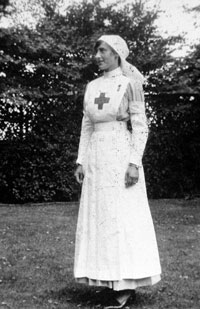
R. C. (Bob) Russell
It may be useful at this point to mention what is understood about the early career of the youngest of the five brothers, R. C. Russell (Bob). He came back to Malaya in 1906 after completing his secondary schooling in England and joined JAR also. Bob left the firm though around 1908, when the boom in rubber as a new commodity had started, and joined Baxendale & Devitt, later known as the Planter’s Stores. Bob then left that company when the rubber boom collapsed a few years later and joined Adolph Hengler, a tin-mining entrepreneur who later formed a holding company named London Tin Ltd., which gained control of the largest foreign-based group of tin mining companies in Malaya. However Bob returned to work for JAR in 1916.
Don came back to Kuala Lumpur with Ethel late in 1917, and they lived in a single storey planter’s-type bungalow at 98 Ampang Road not far from the then centre of Kuala Lumpur. The address is now the site of the large Renaissance Hotel. Their first child, Barbara born in Kuala Lumpur, died as a baby unfortunately in 1918. Peter Alan Russell, their next child was also born in Kuala Lumpur on 2nd February 1919.
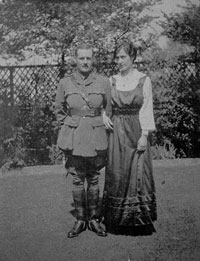
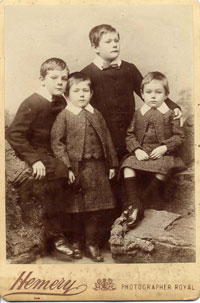
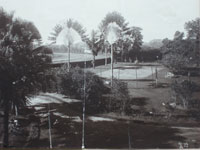
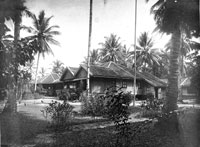
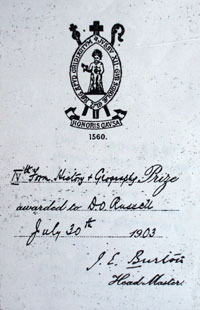
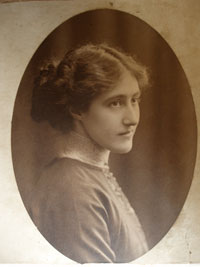
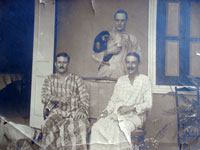
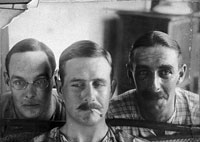
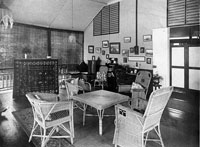
A female liaison
Around 1930 Don met a single lady named Olive Dines aged 29 who had arrived in HongKong earlier. She was called Pam by her friends, and it is clear that Don became infatuated by her and soon formed a liaison with her. The result of that liaison was a son named Michael Donald Russell (the writer of this compilation) after Pam had her surname changed to Russell by deed-poll. Pam travelled to London before the birth of this son in Streatham, probably because of the initial embarrassment that Don and Pam might incur in HongKong by having an illegitimate child. After Michael was about 6 months old, his parents travelled to Ladysmith in South Africa, where Don had to deal with business concerning Loxley Wool Co. (Pty) Ltd. South Africa. Pam and Michael remained there then with an English “nanny” until Michael was about a year and a half old.
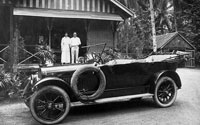
Most of the 1920s, until the world-wide economic slump in 1929, was a period of consolidation and growth for the JAR partnership. Don travelled to Malaya regularly to consult with J.A. on business both there and in China. Mr. H. H. Robbins, an Australian, joined JAR early in that decade. He managed the Wolfram mine in Kedah and Sungei Tua Rubber Estate in Selangor initially, and eventually became JA’s right-hand man in Malaya. MCL continued to expand. After thoroughly studying the subject of tea in 1927 J.A. and an old Ceylon tea planter, A.B.Milne, applied for and obtained a large forested area in the Cameron Highlands in 1928 which they started to clear and plant up. After about a year J.A. bought out Milne and became the sole owner of Boh Estate, which he subsequently made a subsidiary of JAR.
The principal business of WRL at its various branches in China was the import of various commodities for distribution to outlets that sold to both foreign and Chinese enterprises and to households in HongKong and other cities, and the sourcing and export of various Chinese goods. One item that gained some prestige was “Loxley singlets” which were regarded by the Chinese as being of the highest quality. Another imported item was “Dubbin” boot polish, and one of Don’s canny Managers managed to persuade a British regimental sergeant major to have each troop on inspection asked what boot polish he had used; even if the boots were shiny, if the answer was not “Dubbin”, the soldier was told to polish them again. The main branch was in HongKong where Don spent most of his time initially. His compradors there were Mr. Fan Shui Nan and Mr. Kui Cheong. Don also imported the chassis of American Dodge cars, and had truck bodies built on these at an assembly line he had constructed in HongKong, where they were considered to be the strongest trucks available in China.
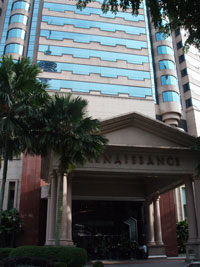
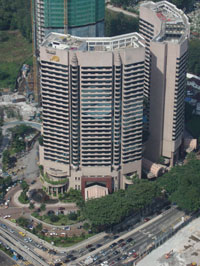
Partnership and business expansion
In 1919 Don became a partner with J.A. in J. A. Russell & Co. The partnership decided to expand outside Malaya and in 1920 they bought the company W.R.Loxley & Co. from the Beattie family. The firm had a branch in HongKong also in London at 106 Fenchurch Street, and later was expanded by the partnership (JARP) into Shanghai, Canton and Singapore. Another business was also bought or established under the name Perrin Cooper & Co. in Tientsin, Hankow and Peking. At some period during the 1920s Don formed both the North China Wool Co. and Loxley Wool Co. (Pty) Ltd. in South Africa, to be owned by the Partnership.
Under the terms of the original purchase of W.R.Loxley & Co., Andrew Beattie became Manager of the London branch. Also in 1920 JARP appointed W. R. Loxley & Co. (WRL) as buying agents in London for Malayan Collieries Ltd (MCL). For this, WRL received a retaining fee and commission on all plant purchased. Where very technical knowledge was required and reference to technical engineers was necessary, WRL’s commission was reduced to 1.5%. The engineers retained by JAR on behalf of MCL in this connection were O. Foster Brown, later Sparks & Partners Ltd., and latterly Mr. Baguley. He was attached to Sparks & Partners Ltd. and when they gave up business, Mr. Baguley was retained to carry on. Mr. Beattie in his capacity of Manager of WRL in London was naturally in close touch with all the affairs of that company, but his actual work in connection with MCL was in engaging staff and related matters. The purchasing of plant and equipment for MCL was done through an export department controlled by Mr. P. G. Beales.
Mr. Beattie had been well regarded by the partners of WRL for a number of years, but this regard gradually diminished owing to the continual disappointment due to yearly results not being up to estimates at the beginning of each period.
Don and Ethel went to England briefly in 1922 and stayed with Ethel’s parents in Sutton, Sussex, during which time David Oscar Russell was born on 14th May 1922.
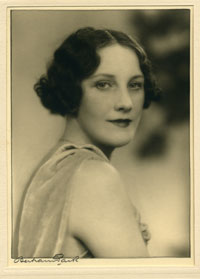
Business in Tientsin
By that time the building owned by Perrin Cooper & Co. in Tientsin (named Tianjin now) had been altered, and Don, Pam and Michael went there to live most of the time. These headquarters were roughly square in shape with a large central courtyard open to the sky. The line of business of Perrin Cooper & Co. and the North China Wool Co. was trading mainly in sheep’s-wool and also some camel’s-wool. The wool was sourced from the interior of north China and Mongolia, and a Norwegian agent, A.H.Rasmussen travelled by any means available to those remote parts where often no other Caucasian had been seen before, to bargain and buy the wool and arrange for it to be brought to Tientsin. The transition of the wool from the sources was usually by camel caravans then on rafts and junks on the Yellow River to Paot’ou, where there was a railway line to Peking, and then by oxen carts to Tientsin. Rasmussen was a very remarkable man, having previously spent over 30 years in the interior of China often organising the armies of various warlords and fighting with them. He knew the characteristics of tough Chinese well and spoke many dialects, and so was adept at hard bargaining.
The rough wool was brought finally in man-drawn carts to the building of Perrin Cooper, and man-handled through a wide archway at the front into the central courtyard. At the two sides and rear of the courtyard there were three floors of a godown with some machinery, where the wool was picked by hand labour, washed, dried on the flat roof, sorted into grades and mechanically bailed for shipment. Tientsin abuts the Hai Ho River, a tributary of the Yellow River near its mouth, where ships could dock and the bailed wool was carted there to be loaded for export mainly to America. High quality camel’s wool was also sold to America where it was in great demand for camel-wool coats.
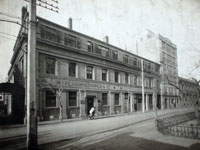
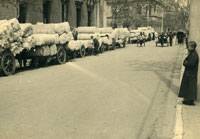
Leisure time around Tientsin
The climate in Tientsin was extremely dry and very cold in the winter, but very hot in the summer with variable humidity, these extremes being influenced by the Gobi desert not all that far inland and by the Bo Hai Gulf to the west. Don and all the British inhabitants of Tientsin were located in the British enclave of the city. There was a very well laid out Country Club with extensive grounds including several lakes and a good clubhouse, where residents could relax from city life. In the winters the lakes froze over solidly and skating was the main form of enjoyment and exercise. Occasionally Don would organise a day’s expedition in winter into the flat countryside beyond the enclave. The use of a sampan on skids, owned by a Chinese man, was rented and family and friends would load it up with baskets of food and warm rugs, and all would sit in it well wrapped up. The owner would pole the toboggan-like sampan along frozen-over canals for a mile or so, and then all would get out onto firm ground and start a blazing bonfire on which some of the food was cooked. After some chasing around for exercise and warmth, a picnic-type lunch was enjoyed and then all were poled back along the canal to the city. Another facility in Tientsin for foreigners and wealthy Chinese was a race-course with comfortable seating and, for those who were enthusiastic, races with Mongolian ponies was an enjoyable pastime held periodically. The coronation of King George VI was celebrated there with an elaborate fireworks display in the evening.
For those Chinese who were uneducated and poorly paid, life was completely different, sadly in retrospect. There were those who pulled the wool-laden carts like pack horses and normally called “coolies”, and who were clothed in light tattered garments in the heat of summer and ragged padded-wear during the very cold winters. Their children could be seen in the streets sometimes, and at the start of winter they were sewn into one-piece garments, filled with raw wool, which covered everything but their faces, hands and feet. There was a slit below their back-sides to cater for their excrements, but they remained clothed in this same garb for the whole of the winter months !
Holidays in North China
During the 1930s Japan was trying to take over north China militarily and though gun shots and rifle fire could not be heard in the British concession in Tientsin, spent bullets were sometimes found on the flat roof of the Perrin Cooper building. Every summer Don and Pam with Michael would take a holiday of a couple of weeks at a seaside resort called Peita-ho (now named Beidaihe). The journey there was by train to a village a couple of miles inland from Peita-ho, and Japanese soldiers were evident on the train showing they were in charge and checking that no unauthorised personnel were on board (see the photo of Don’s Pass right issued by the Japanese). It had been previously arranged that when the train arrived at the village, labourers were there with donkeys to meet the few disembarking people and carry them and their baggage on the donkeys for the couple of miles to the resort beach. On the way it was usual to stop at one of the poultry smallholders and choose a couple of live chickens which were then caught by the owner for our supper. He would cut their necks on the spot, and a gruesome but rather amazing sight for a small boy was to watch one of the chickens occasionally continue to run around the caged area briefly with its head cut off. Peita-ho resort consisted of only a few holiday cottages in a curved bay with a beautiful sandy beach, which terminated in a headland to the north and rocks with pools to the south, where fascinating saltwater creatures could be found. Catering and cleaning in all of the cottages was done by a plethora of servants who appeared to be permanently employed for this work. It is said that, after the Communist regime came to power in China, this resort area has been altered and used by them exclusively for the past several years as a centre for high level political meetings.
Living in Tientsin
Looking at the Perrin Cooper headquarters again, the ground floor of the front of the building, on Consular Road, was offices while the two upper front floors were the living quarters for the small family to occupy (see photos). The area of this apartment was quite extensive, with a formal dining-room and two large drawing rooms, one called the Silver Room and the other the Gold Room at the front of the first floor. Behind them, separated by a corridor, were a daily dining-room, a bar-room and the kitchens. The top floor was comprised of the bedrooms with bathrooms, and included a playroom for Michael who was looked after much of the time by a Chinese Amah. Most of the apartment was furnished and decorated with Chinese items, some of which were antique. Domestic servants were plentiful and so only the most competent and honest Chinese were employed. There were about twelve servants for this small family.
The Silver Room was used for cocktail parties and general entertainment of guests, and near the windows were three large birdcages containing two talking parrots and one talking mynah bird, which was considered ethical in those years. Michael was allowed to be “exhibited” at drinks parties occasionally, and one of the parrots was released from its cage sometimes and would perch on guests’ shoulders. Michael remembers being greatly amused when it would then take a sip of several guest’s drinks until it became quite tipsy and started to fly around the room erratically, swooping among the guests ! The Gold Room was used mainly as a quiet family room, and with the gold wallpaper depicting typical scenes of Chinese countryside and villages, Don with Michael sitting in his lap used to make up stories sometimes, of the latter exploring the depictions on the wallpaper.
Tientsin carpets
When Don first started living there, “Tientsin Carpets” were of good quality but were sold mostly locally. It was a cottage industry and the weavers had to sell their products to Chinese self-appointed agents for whatever little price they could bargain. One of the initiatives Don took on his own shoulders was to form a type of cooperative organisation, to which the cottage weavers could sell their carpets for a fair price. The outcome of this was that the weavers made a reasonable living of course, and that Tientsin Carpets became better known and sought after worldwide. They are still produced now from that region but sadly since the rule of communism these carpets have been industrially mass-produced and their quality has fallen away.
World War Two & Internment in Hong Kong
After the Japanese entered the Second World War, they occupied China and HongKong first and so Don was captured as a civilian in HongKong and interned in Stanley Camp there.
He was appointed Chairman of St. Stephens area of the camp, which involved overseeing all aspects of that part of the camp, and reporting to the Japanese commandant of the camp when required.
Don said later that the civilian internees were not physically abused, except when punishment was meted out for unauthorised acts, but the main problems were starvation and health. There was little food apart from small daily portions of rice and what little vegetables the internees could grow, and they had to resort to catching rats and other pests to eat for protein. All the internees who survived lost a great deal of strength and weight (see photo).
Don himself was reduced from about 12 stone to 7 stone after four years of imprisonment. When the camp commandant realised that his country had been defeated, after the US had decimated two of their cities with the atom bomb, he called for Don to be brought to his office. Don feared the worst that might happen to him, but the commandant presented him with a warm coat and a banana to ameliorate Japan’s actions during the war. The commandant insisted Don put on the coat and ate the banana in his presence, which Don did with great reluctance since he hated bananas after having eaten too many as a boy in Malaya.
On 30th August 1945 the British forces took back control of HongKong, and Admiral Cecil Harcourt came to relieve Stanley Camp (see photo of Don with Admiral Harcourt). Don soon went back to England for a couple of months to recuperate and gain strength and weight, and then returned to HongKong and China to try and rejuvenate the businesses.
Hard years
The worldwide economic slump which started in 1929 brought on financial difficulties for the JAR partnership, as it did for most businesses and individuals around the world, while the partnership was still trying to expand. Significant bank loans were needed and were obtained with much of the assets accepted as collateral, but the JARP expansion did continue. However disaster struck when J.A. (Archie) suddenly died on 7th April 1933 after a short illness.
J.A.’s executors set up a Trust for the benefit of his wife Kathleen and very young son Tristan, and Don was a Trustee of this for many years. However in his will J.A. had not actually stated that his assets could be kept in non-trustee stock. With Malaya being a British colony then, British Trust laws had to be followed and these were very strict as to what constituted trustee and non-trustee stock in those days. The Court in Kuala Lumpur ruled that only the business of JAR & Co. could be put in Trust and that all J.A.’s holdings in the other businesses had to be sold off. The serious difficulty of the situation and how it was solved are stated in notes left by Don and described here.
The total advance of Straits dollars (ST$) 525,000 to Don was utilised as follows:
WRL & Co. (London) Ltd. Capital £15,000 = ST$128,500
WRL & Co. (China) Ltd. Capital HK$200,000 = ST$140,000
PC & Co. Capital CN$150,000 = ST$ 78,000
PC & Co. Extra cost of property = ST$178,500
_____________ ST$525,000
Gradually over the years until the Japanese entered the Second World War, Don was able to pay the interest on the loans and reduce them, using the profits of these businesses and from dividends in his 25% share in J.A.Russell & Co. Ltd. (which had been formed into a Limited Company soon after J.A.’s death) to ST$351,580.78
Don had bought a house, The Old Barn, for Pam Russell at Felpham near Bognor Regis, Sussex prior to 1938 and arranged in 1938 for two Chinese servants, Wong and Dao from Tientsin, to be taken by ship to England to work at that home. Also in 1938 Pam took her son Michael Russell back to England to start boarding at a prep-school named Mowden in Hove. After the war with Germany started in 1939 it was thought prudent that Wong and Dao should return to Tientsin, but before that Don used to spend a little holiday time at the Old Barn so the small family spent some time together there during Michael’s school holidays. Luckily for Pam and Michael, they remained in Britain during the Second World War, but Don was back in Tientsin and HongKong by late 1939 .
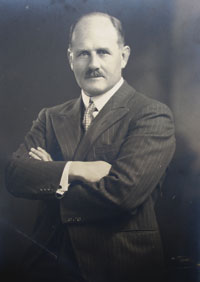
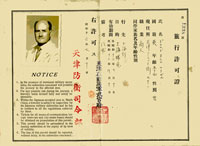
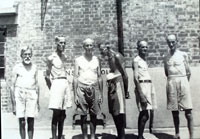
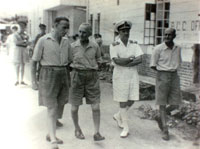
Re-establishing business after the war
All the businesses in China and HongKong had of course been appropriated and looted by the Japanese. In Tientsin it was very fortunate that Don had employed since many years pre-war a very astute manager named Mr. Murray who, being of mixed race with Philippine origin, was not interned by the Japanese. Upon surrender by the Japanese, Murray immediately obtained the assistance of the highest Commanding Officer in the US Army in Tientsin, where they had relieved the occupation, and persuaded the officer to summon the Japanese Commandant and take him and a squad of US soldiers to the Perrin Cooper building. All the Japanese troops who were occupying the building were rounded up and held, and the Japanese Commandant was told to order that all the factory and office equipment, and any missing household furniture, must be brought back within 48 hours by any other troops involved in looting, or else those held would be shot by the US squad. Of course, not all the equipment and furniture was found and returned, but a quite a lot was.
After the war there was in Malaya a War Damages Reparation Scheme, from which British industries and companies were compensated to some extent for damage done by the Japanese occupation. As HongKong was a British colony then that same scheme may have been instituted there, but it would not have been so in Tientsin which was part of China with only foreign enclaves. As stated above, Don still owed ST$351,580.78 to HongKong & Shanghai Bank via J.A.Russell & Co. Ltd. at the start of the war with Japan, for the purchase of WRL & Co., London & China, and PC & Co. WRL & Co. London was still a going concern on a small scale, with Pam Russell being appointed as one of the directors in January 1943, but it is not know how the outstanding loan for all of Don’s companies was resolved, bearing in mind that the branches of the bank in China and S.E.Asia would have been in the hands of the Japanese also during the war. Perhaps there is some record of how this loan was resolved in the post-war records of J.A.Russell & Co. Ltd. To the best of knowledge though, Don owned these companies fully without any debt after the war until the Chinese Communist regime took control of north China including Tientsin; but the latter event is mentioned later in these notes.
An altercation with brother Bob
R. C. Russell (Bob) had been employed by J.A. initially in 1906 and worked for him, for the J.A.Russell partnership and for J.A.Russell & Co. Ltd, on and off whenever he was in Malaya. It is not apparent that he ever became a Partner at any time, but he was a director of MCL after J.A. died. However he was asked to resign from J.A.R. & Co. by H. H. Robbins in 1937 and went to Canada initially.
Don often asserted that Bob was the brother that spent most of the money that the partnership earned, and that he was regarded as the “black sheep” of the family. Bob was not in the Far East at all during the Second World War and was therefore not captured, but was in England by 1944 and was still a director of MCL. Even during the Japanese occupation of Malaya, there was an intention from the Malayan Planning Unit in England that priority should be given to restarting Malayan Collieries as quickly as possible after the war ended. This of course assumed that the Japanese would be defeated.
During the latter part of the war Andrew Beattie reappeared on the scene in London and was approached initially by the Malayan Planning Unit concerning the reopening of MCL. The only other director of MCL who had both escaped capture and returned to England was Mr. A.J.Kelman and he heard that the Malayan Planning Unit had been in touch with Andrew Beattie, so he advised WRL & Co. London of this.
Protracted discussions took place between WRL & Co. and Andrew Beattie as to which of the two companies was the appointed agent for helping to restart MCL with all the equipment required. This culminated for the time being with a letter headed as Malayan Collieries Ltd. and signed by R.C.Russell as Secretary, stating that Andrew Beattie & Co. (London) Ltd. was the London agents for MCL. Since WRL (London) had been appointed as agents for MCL originally, and as it had a quantity of export goods unsold in England and also a large amount of cargo diverted to Australia since the start of the Japanese occupation, a huge row ensued between Don and Bob after Don’s release from Stanley camp. The details of this whole episode were very complicated and are explained as much as possible in documents written by Don.
After attending to the revitalisation of the businesses in China and HongKong, Don made his base in England and bought a large home, Ashton Manor, with some tenanted farmland in Devon in the mid-1940s.
He lived there with Pam, but made annual visits to Malaysia as a director of JAR & Co., and to his businesses in HongKong and Tientsin. He and Ethel were not actually divorced until 1946.
Takeover by the Communist Party
The Chinese Communist Party (CCP) had been fighting the Kuomintang in a civil war for the control of China for many years and was finally successful in taking control of the whole of mainland China in 1949. However before that, the CCP had controlled the northern half of China from their headquarters in Beijing, and took over the foreign concessions in Tientsin in the second half of the 1940s.
All businesses there, which included Perrin Cooper & Co. Ltd., were told that they would be expropriated without compensation. Don’s excellent manager there, Mr. Murray, came to the rescue again as much as he was able to. He managed to arrange an interview with a senior official of the CCP, and said to him in effect that “all the eyes of the political world were on the anticipated control of the whole of China by the CCP, and the Party would be judged by how it behaved in treating foreign people and paying for taking over their businesses”.
This resulted in Don receiving a small amount of compensation for PC & Co., but not nearly what it was worth of course. Don was extremely grateful to Mr. Murray who was suitably rewarded for all his years of loyalty and astute management, and it is believed Murray returned then to the Philippines, his country of origin. Thus ended Don’s business affairs in mainland China.
Continuation of business in Hong Kong
Don continued to own WRL in London and in HongKong, where his manager was a man named Fritz Meyer who lived with his wife Sheila in an attractive apartment half-way up the Peak. On arrival, a staying guest was always offered a drink in the sitting-room opening out onto the balcony, and his suitcase was taken to his bedroom by one of the servants. When the guest went to the bedroom, he found that his suitcase had been opened, all the clean clothes put neatly into the wardrobe and drawers, and all the soiled ones taken away already for washing. The Comprador for WRL HongKong was a Mr. Yau, who had a large home on the island, in which not only he and his wife lived but also several of his sons and daughters. Many of Mr. Wong’s grandchildren stayed there as well. The extensive house was roughly square-shaped and several storeys high, with a large area for dining and entertaining in the centre extending up to the height of the roof. The bedrooms and living areas surrounded the four sides of this central room on each storey. Whenever Don visited the business, Mr. Yau would give a sumptuous Chinese dinner at his home for Don, the Meyers and other senior WRL staff, lasting two or three hours with many courses and hospitable toasts between each. During the dinner, Mr. Yau’s many grandchildren could be seen peeking through the lattices surrounding the large dining area to watch the proceedings with awe and amusement.
Don finally sold W. R. Loxley (HongKong) Ltd. to Blythe, Green & Jordain Ltd. sometime in the mid-1950s, and it is believed W. R. Loxley (London) Ltd. was wound up and closed shortly later. In 1950 the Colorado School of Mines, Don’s Alma Mater, awarded him their Distinguished Achievement Medal in recognition of his business accomplishments since his graduation in 1909.
Retirement in Britain
Don continued to live at Ashton Manor, Devon, with Pam but they only actually married on 21st April 1952.
The house was filled with Chinese furniture, original Tientsin rugs, ornaments and some antiques, all of which had been either rescued from the Tientsin apartment or brought back from HongKong.
Pam was always keen on having friends come to stay or dine. She had one full-time and one part-time women to help in the house, and she enjoyed cooking Chinese dinner parties for friends. Don enjoyed attending to the large vegetable garden and to the walled fruit garden and greenhouses, with the help of a full-time gardener and a handy-man. He was also happy mowing the extensive lawn at the front of the house, using a sit-on mower, but on one occasion he lost control of it and ended up in the small stream running through the area of lawn! The property owned a stretch of the river Teign, which was good for sea-trout and salmon fishing, but did not hold many brown trout. Don and Pam both fished the river occasionally but she was the keener fisher of the two.
It is thought that the effect of having been interned in HongKong, with only other men and no freedom for four years, made Don uncomfortable with the large mixed group of people that Pam enjoyed. At any rate, the relationship between Don and Pam became more and more strained over the next few years at Ashton Manor, and they were divorced around 1957.
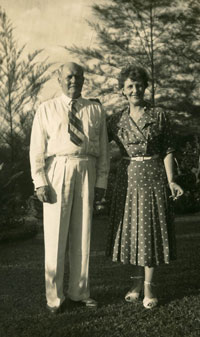
A move to Jersey and Don’s last years
Don moved to Jersey in the Channel Islands and bought a bungalow at 4 Victoria Avenue, St. Helier, leaving Ashton Manor to Pam. He made a few good friends there, and continued his visits to annual general meetings at J. A. Russell & Co. in Malaya, where he had become deputy chairman with William Gemmill, Tristan Russell’s step-father, as chairman.
Don suffered quite a severe heart-attack in Jersey on 5th July 1961 and was rushed to the hospital there. It appears that Michael Russell working in Malaysia (as the nation was constituted by then), was the only family member whose phone number was known to Don’s friends in Jersey and he was informed immediately. As a son, he flew to Jersey straight away and was lucky be able to visit Don in hospital on 7th July, where he found him seriously ill but able to speak. Michael stayed in a hotel in Jersey that night, but was woken in the early hours of the morning on 8th July with a phone call from the hospital to say that Don had just suffered a further massive heart-attack and died. He was 73 years old at the time.
Don’s funeral was arranged for the morning of 13th July at St. Andrew’s Church, St. Helier. His executors notified as many other members of Don’s extensive family as they could, from any obvious data of Don’s, about his death and impending funeral.
Two of Ethel’s children, David and Richard Russell, came from England for the funeral and Michael was already in Jersey. That occasion revealed an astonishing secret of Don’s. He had managed to keep hidden from Michael completely, since the latter’s birth in 1931 until that funeral, that he was married previously and that Michael had five half-brothers and sisters !
David and Richard were surprised to meet Michael also and it seemed as if they new little if anything about his existence. You can imagine the utter amazement for both sides of Don’s families at that funeral, and for Michael to realise for the first time suddenly that he had been born illegitimately ! Pam obviously knew the situation but was urged to secrecy which she admitted subsequently, and no doubt several business colleagues of Don’s also knew.
It has recently been revealed by Don’s youngest daughter, Elizabeth, that she was told of the situation by her mother Ethel, and in fact went to see Pam at W.R.Loxley’s London office just after the war to ask her to urge Don to provide a little more funding so that she could study to complete her qualifications.
Don was buried at Surville Cemetery at St. Helier, Jersey (See photo left)
So ended the complex and varied life of Donald Oscar Russell. His associates and friends have spoken of him as a man of great endeavour, endurance, compassion and quiet humour, who never broke his word.
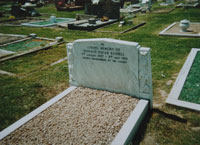
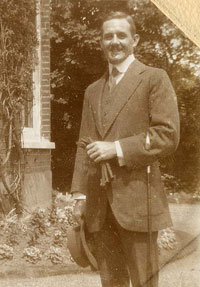
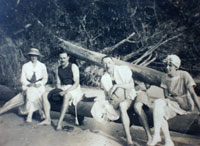
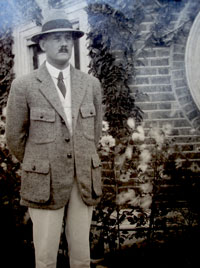

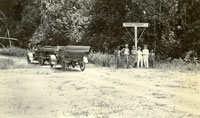
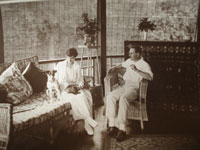
Moving to China and Hong Kong
It was also decided in 1922 by the JAR partnership that Don should move to China to take control of the businesses there, while still travelling to Kuala Lumpur occasionally to liaise with J.A. on the various ventures in Malaya. So Don, Ethel and their two children moved to live in HongKong in late 1922 or early 1923. Another two children were born there, Marjory Russell on 3rd September 1923 and Richard Andrew Russell on 29th October 1925. Don then brought the whole family to England in 1926 to live at Glyn House, Epsom. There are conflicting versions whether this was for Ethel’s health in a cooler climate, or that Ethel wanted to be with the children as they grew up and attended school. In any case, Ethel stayed in England thereafter, but Don had to spend most of his time in China attending to the businesses. Another daughter, Elizabeth Ann was born though in Epsom.
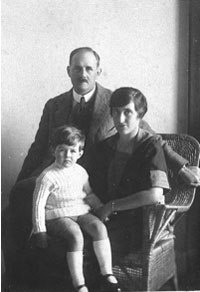

Notes.
(1) "Coolies" This is the word used in the original document written in 1914 and found in the Selangor Secretary Files by researcher Mr. Wong Yee Tuan.
